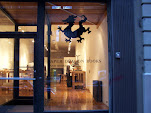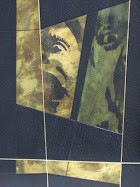

Day 14...board linings and rounding Spine forms.
......the boards cut from an 80pt, or 3mm board, are lined with a smooth bristol board on the outside using PVA.
Now, because we're using these for making leather cases, and because those cases are covered in onlays, I paste and stretch an acid neutral cotton fibre 25lb bond paper across the board, which initially pulls them inwards, but will later help the boards set rigid and flat.
I can't cut the material for making the rounded Spine Forms without first lining the boards as a true measurement can only be taken with the trays between boards.
I use BINDERS BOARD to make the rounds!!!Not Balsa, Not paper,not toilet rolls!!!
It is readily available, easily sculpted in the right hands, and provides a good solid back to the box,structurally sound and good for tooling.
Different strokes for different folks!!
The base board is cut to the width of the trays between boards, then built up by successive possibly thinner boards, in a pyramid.These are glued together, then rather perversely I hand plane them into curve using a kraft knife.
Its not for everyone, but I do like the control it gives me.
After planing, they are then sanded with a 30, 50, or 80 grit sand paper.Use a heavy paper and wear a mask.
These will then be covered, and after that the spine pieces for the cases can be cut, and cases made....over 30 of them......easy, right????!!!
The bristol board and lining paper is available and affordable from Hollinger's, I will post a link in the list of freinds.



















